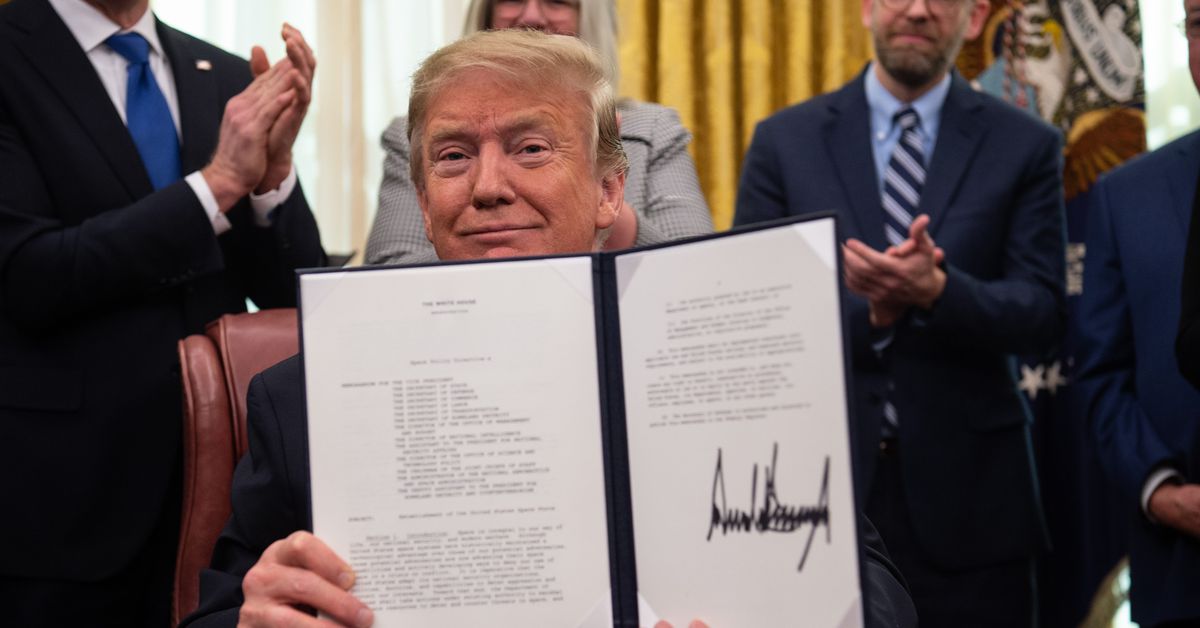
Today, President Trump signed his fourth space policy directive, this one aimed at creating the infamous Space Force he has been touting since last summer. However, the scope of the Space Force has been downsized. The new policy directive will make the Space Force a sixth branch within the US Air Force, rather than its own independent department.
Trump first directed the Department of Defense to establish the Space Force in June 2018 in a surprise announcement during a meeting of the National Space Council. At the time, he argued that the organization would be a new, sixth branch of the military. “We are going to have the Air Force and we’re going to have the Space Force, separate but equal,” Trump said at the time. “It is going to be something so important.” Since then, DOD officials have been debating exactly how to structure this new branch and what it would cost.
However, creating a new military branch ultimately requires legislation from Congress, and many lawmakers have expressed their opposition to setting up an independent Space Force. Now after months of debate within the Pentagon, the Trump administration is proposing to initially create the Space Force within the Air Force instead, similar to how the Marine Corps is operated out of the US Navy. The directive calls for the creation of a new position, a Space Force undersecretary, who will report to the secretary of the Air Force, according to an early draft of the directive obtained by Space News. However, the administration hopes that this will be the “first step” toward creating a separate Space Force branch at some point, the draft says.
Even with this change, Congress will still need to agree to the idea and provide funding for the restructuring. But the administration may have an easier time getting congressional approval for the Space Force if it’s created within the Air Force, which is already responsible for overseeing many of the military’s most crucial satellite missions. “The DOD has been scrambling to figure out what the details are and along the way had this discussion of… what’s actually feasible to get through Congress and what’s actually going to be able to make a positive difference?” Brian Weeden, director of program planning at the Secure World Foundation focusing on space operations and policy, tells The Verge.
A proposal similar to the president’s directive was made once before. In 2017, Rep. Mike Rogers (R-AL) and Rep. Jim Cooper (D-TN) proposed the idea of creating a Space Corps within the Air Force, which would oversee all of the military’s space activities. They argued that many of our satellites in space are vulnerable to attack, and while the Air Force is responsible for these US space assets, the branch also has a lot of other things to worry about. Rogers and Cooper claimed that reorganizing the Air Force and creating a centralized Space Corps would ensure the safety of our satellites and spur new missions.
There was some bipartisan support for the idea and the House even passed the proposal. However, it ultimately didn’t make it into the final National Defense Authorization Act for 2018, which details the priorities and budget for the Defense Department each year. In fact, members of the Trump administration were opposed to the idea of a Space Corps at the time. James Mattis, the former secretary of defense, argued it would create “additional organizational layers at a time when we are focused on reducing overhead and integrating joint warfighting efforts.”
After the Space Corps idea was shot down, Congress decided to commission a study to figure out the best way to reorganize the military’s space efforts. While that was going on, Trump became enamored with the idea of a Space Force, and the Department of Defense then had to figure out the details of this proposed new military branch, as well.
Since the Space Corps idea did receive congressional support initially, this new concept for the Space Force may be more palatable to lawmakers who were against a completely separate branch. Additionally, a department within the Air Force would theoretically require less overhead and upfront costs than the creation of an independent Space Force, especially since many of the military personnel who handle space missions are within the Air Force already. “The biggest benefit of it is that it avoids a lot of the overhead problems,” says Weeden. “If you create a whole new department, there is a ton of overhead stuff that’s going to come along with that that you have to devote resources and people to.”
A leaner Space Force may also be able to cope with potential new restrictions on military spending. The Budget Control Act (BCA) of 2011 imposes spending caps on the federal budget. Congress agreed to temporarily waive the caps for two years in 2018, but if lawmakers don’t come up with an agreement do that again, they’ll be limited in how much government funding they can appropriate. Fitting in a costly new military branch into this scenario probably wouldn’t have flown. “If Congress does nothing, the caps automatically go back into place,” says Weeden. “And it would be a huge cut to the Pentagon top line.”
Still, the fate of this new Space Force will stay undecided until Congress makes a decision on whether to act upon this directive. The administration is likely to release more details about how it thinks the Space Force should be funded in the president’s yearly budget proposal, which is slated for mid-March.
Update February 19th, 4PM ET: This article was updated to clarify the distinction between the Space Force as a separate department versus a branch under the Air Force.
https://www.theverge.com/2019/2/19/18231450/space-force-military-branch-policy-directive-4-trump

